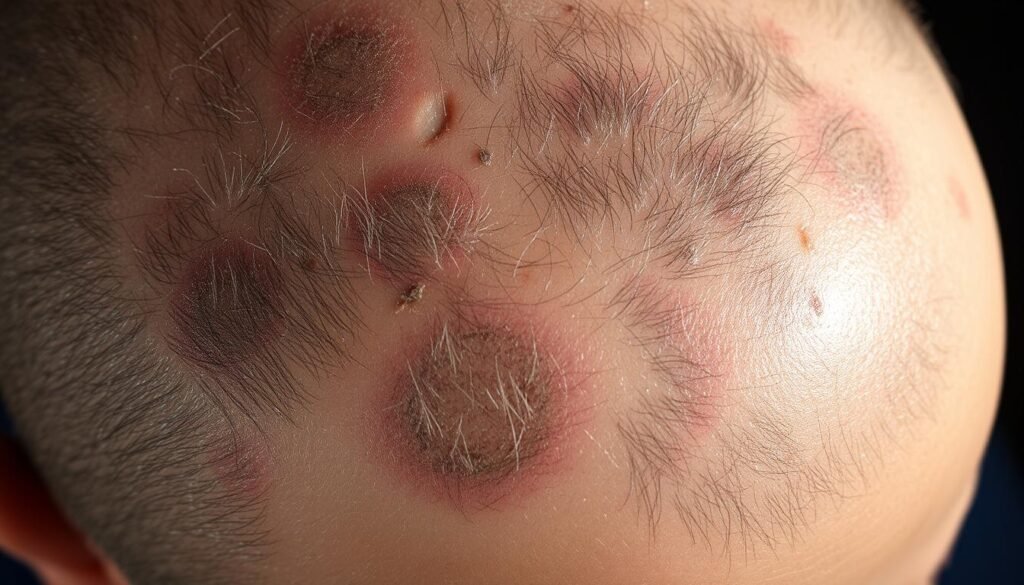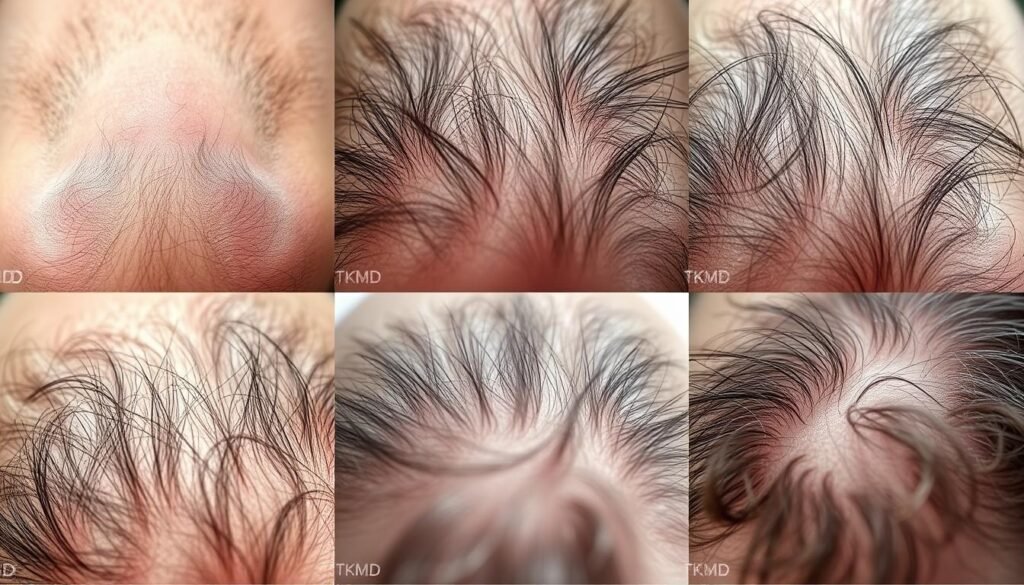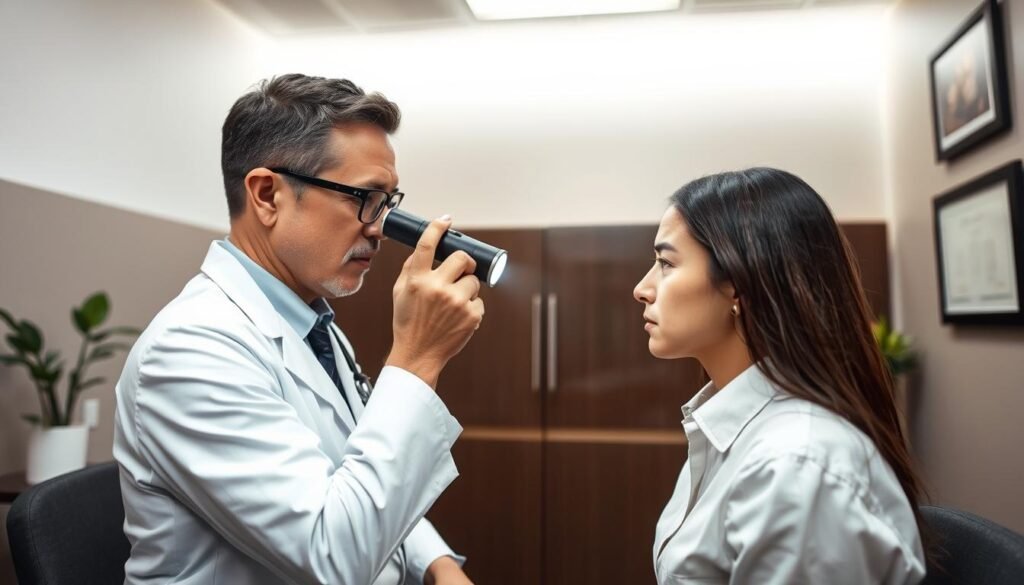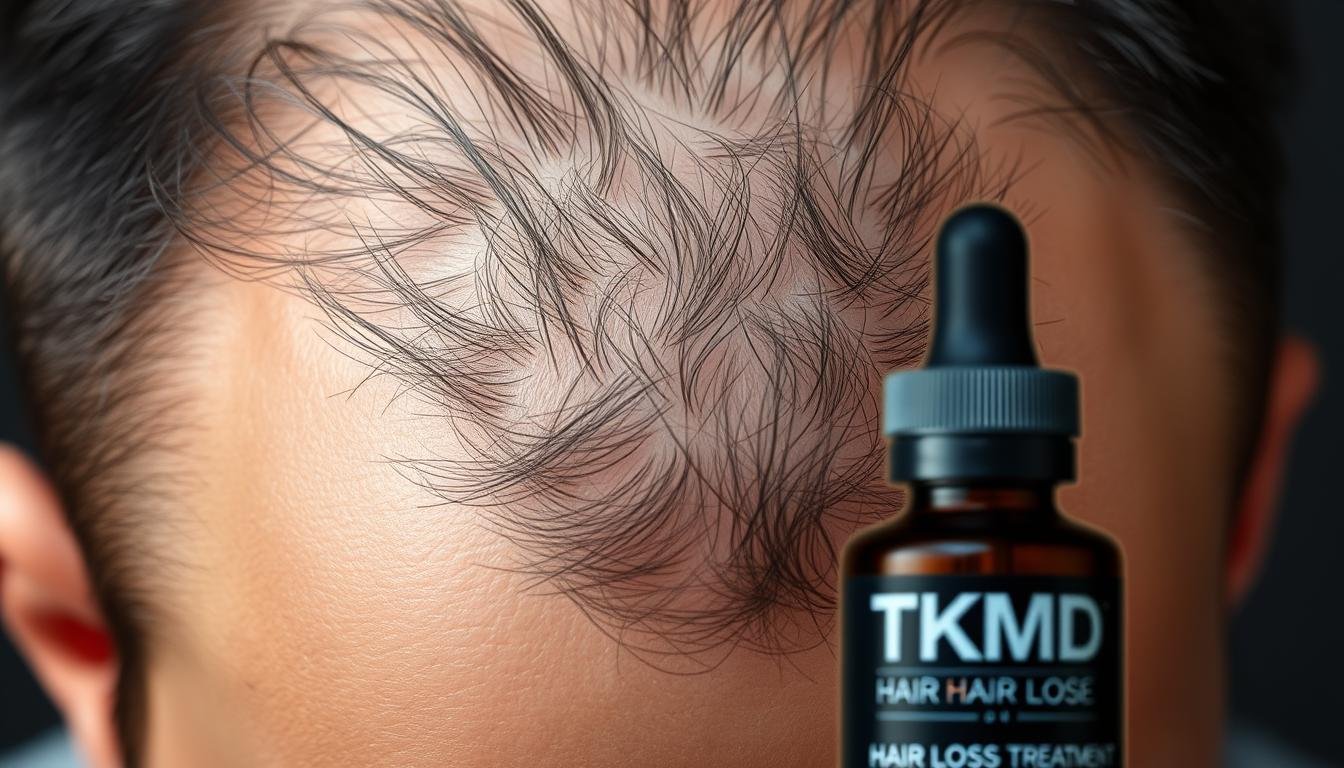Losing hair can be a distressing experience, affecting not just your appearance but also your emotional well-being. It’s a common issue that can stem from a variety of factors, including genetics, hormonal changes, stress, and certain medical conditions. Understanding the underlying cause of your hair loss is crucial for finding the right treatment.
Consulting a specialist, such as a trichologist or dermatologist who focuses on hair and scalp conditions, can provide you with expert diagnosis and personalized treatment options. They use advanced diagnostic techniques to identify the specific cause of your hair loss, which is essential for effective treatment.
Early intervention can prevent further hair loss and potentially restore growth. By seeking professional help, you can take the first step towards addressing your concerns and regaining your confidence.
Key Takeaways
- Consulting a hair specialist can provide access to expert diagnosis and personalized treatment options.
- Advanced diagnostic techniques help identify the specific cause of hair loss.
- Early intervention can prevent further hair loss and potentially restore growth.
- Understanding your medical history is crucial for creating an effective treatment plan.
- Specialized care is essential for addressing hair loss and scalp health.
Understanding Hair Loss and Its Impact
The impact of hair loss extends beyond the physical realm, influencing emotional health. Hair loss can occur due to a variety of reasons and affects individuals in multiple ways, both physically and emotionally.
Common Signs of Hair Loss
Common signs include excessive shedding, thinning, or balding. These changes can be distressing, signaling the need for attention to one’s hair health. For more information on maintaining overall skin, hair, and scalp health, visiting a specialist who deals with skin, hair, and scalp health can be beneficial.
Psychological Effects of Hair Loss
Hair loss can lead to significant psychological distress, including anxiety, depression, and social withdrawal. The emotional impact varies based on the extent of hair loss and individual circumstances.
What Causes Hair Loss?
The reasons behind hair loss are varied and can be attributed to several key factors. Hair loss can be a distressing condition, affecting both men and women.
Genetic Factors
Genetics play a significant role in hair loss, particularly in cases of androgenetic alopecia, also known as male and female pattern baldness. This condition is hereditary and can be inherited from either parent.
Medical Conditions
Certain medical conditions can lead to hair loss. For instance, thyroid disorders, autoimmune diseases like alopecia areata, and skin conditions such as psoriasis can cause hair loss. Consulting a healthcare professional is essential for diagnosis and treatment, as seen on UChicago Medicine.
Lifestyle and Environmental Factors
Lifestyle and environmental factors, including excessive hair styling, poor diet, and exposure to pollutants, can contribute to hair loss. Maintaining a healthy lifestyle can help mitigate some of these factors.
Stress and Hormonal Changes
Stress and hormonal changes are significant contributors to hair loss. Events like childbirth, menopause, and significant stress can cause temporary hair loss. For example, telogen effluvium, a condition triggered by stress, pushes hair follicles into the resting phase, leading to excessive hair shedding. As noted, “Stress-related hair loss typically resolves once the stressor is removed, though recovery may take 6-12 months as the hair growth cycle normalizes.”

Types of Hair Loss Conditions
Understanding the different types of hair loss is crucial for effective treatment. Hair loss can be caused by a variety of factors, leading to different conditions.
Androgenetic Alopecia
Male and Female Pattern Baldness is a common form of hair loss. It’s characterized by a gradual thinning of hair, particularly on the scalp, due to hormonal influences and genetics.
Alopecia Areata
This is an autoimmune condition where the body’s immune system attacks the hair follicles, leading to patchy hair loss. It can affect any part of the body.
Telogen Effluvium
This condition causes a significant increase in hair shedding after a stressful event, illness, or nutritional deficiency. It’s often temporary.
Cicatricial (Scarring) Alopecia
A rare condition where inflammation destroys hair follicles, replacing them with scar tissue, resulting in permanent hair loss. Early diagnosis is crucial.
| Condition | Cause | Outcome |
|---|---|---|
| Androgenetic Alopecia | Hormonal & Genetics | Permanent |
| Alopecia Areata | Autoimmune | Variable |
| Telogen Effluvium | Stress, Illness | Temporary |
| Cicatricial Alopecia | Inflammation | Permanent |

When to See a Hair Doctor Near Me

Understanding the right time to see a hair doctor near you can significantly impact the effectiveness of your treatment. Hair loss can be a challenging condition to address, especially if it has progressed significantly.
Warning Signs That Require Professional Attention
If you’re experiencing excessive hair shedding, bald patches, or a receding hairline, it’s time to seek professional help. These signs may indicate an underlying issue that requires care and attention from a hair doctor.
Benefits of Early Intervention
Early intervention for hair loss significantly improves treatment success rates. By seeking help early, you can preserve active hair follicles, potentially avoiding the need for surgical interventions and achieving better results. Some key benefits include:
- Prompt diagnosis and treatment of underlying medical conditions contributing to hair loss.
- Preservation of active hair follicles before they become dormant or damaged, promoting hair growth.
- Simplified, less invasive treatment protocols.
- Accurate diagnosis and realistic expectations about results.
What to Expect During Your First Consultation
Understanding what happens during your first visit to a hair doctor can help alleviate anxiety and prepare you for the process. The initial consultation is a comprehensive evaluation that involves assessing your hair loss and determining the underlying causes.
Initial Assessment and Medical History
The consultation begins with an initial assessment and a review of your medical history. This step is crucial in identifying potential factors contributing to hair loss. Your specialist will gather information about your overall health, previous illnesses, and any medications you are currently taking.
Physical Examination of Hair and Scalp
A thorough scalp examination is conducted to assess the condition of your hair and hair follicles. This may involve a macroscopic assessment, dermatoscopy (trichoscopy), and a hair pull test to determine the extent of hair shedding and identify any visible abnormalities on the skin or scalp. In some cases, a blood test may be required to check for underlying conditions affecting blood health.

Diagnostic Methods for Hair Loss
Understanding the underlying cause of hair loss requires a combination of clinical evaluation and specialized diagnostic techniques. Accurate diagnosis is essential for determining the most effective treatment plan.
Scalp Biopsy
A scalp biopsy involves removing a small sample of skin from the scalp for examination under a microscope. This procedure helps diagnose conditions such as cicatricial alopecia and other scalp disorders.
Blood Tests
Blood tests are used to identify underlying medical conditions that may be contributing to hair loss, such as thyroid disorders or autoimmune diseases. These tests can help guide treatment decisions.
Dermatoscopy
Dermatoscopy, also known as trichoscopy, is a non-invasive diagnostic technique that uses a specialized handheld microscope to examine the scalp and hair shafts at high magnification. This method reveals subtle features that are not visible to the naked eye, aiding in the diagnosis of various hair loss disorders.
- Dermatoscopy examines the scalp and hair shafts at 10-70x magnification without invasive procedures, revealing miniaturized hairs and perifollicular inflammation.
- Different hair loss disorders display characteristic trichoscopic signatures, such as yellow dots and exclamation mark hairs in alopecia areata.
- This technique helps monitor treatment response over time by documenting changes in hair density and scalp condition.
| Diagnostic Method | Description | Usefulness |
|---|---|---|
| Scalp Biopsy | Microscopic examination of scalp skin | Diagnoses cicatricial alopecia and scalp disorders |
| Blood Tests | Identifies underlying medical conditions | Guides treatment decisions for hair loss |
| Dermatoscopy | Non-invasive examination of scalp and hair | Aids in diagnosing various hair loss disorders |
By employing these diagnostic methods, healthcare professionals can accurately diagnose the underlying cause of hair loss and develop an effective treatment plan.
Treatment Options for Hair Loss

There are multiple treatment options available for individuals experiencing hair loss. The choice of treatment depends on the underlying cause, extent, and type of hair loss.
Topical Medications
Topical medications are applied directly to the scalp to stimulate hair growth or slow down hair loss. Common examples include minoxidil, which is available over-the-counter.
Oral Medications
Oral medications, such as finasteride, are taken by mouth to treat hair loss. They work by addressing hormonal imbalances that contribute to hair loss.
Injections and Advanced Therapies
Injections, like platelet-rich plasma (PRP) therapy, involve injecting growth factors into the scalp to stimulate hair growth. Advanced therapies also include low-level laser therapy (LLLT).
Surgical Options
Surgical hair restoration, including hair transplantation, involves relocating hair follicles from donor areas to thinning or bald regions. Techniques include Follicular Unit Extraction (FUE) and Follicular Unit Transplantation (FUT).
- Hair transplantation involves harvesting hair follicles from donor areas and implanting them into thinning or bald regions.
- Modern techniques include FUE and FUT, with FUE offering minimal scarring but potentially higher costs.
- Ideal candidates have stable hair loss, good donor hair density, and realistic expectations about results.
After a hair transplant, it takes time for the hair to grow, with noticeable results developing gradually over 8-12 months. A person can expect to return to normal activities within 1-2 weeks.
Non-Medical Hair Loss Solutions
Non-medical hair loss solutions have gained popularity as they provide a less invasive means of dealing with hair loss, catering to a wide range of needs and preferences. These solutions are particularly appealing to individuals who are not ready or willing to undergo surgical procedures or long-term medical treatments.
Wigs and Hairpieces
Wigs and hairpieces are a popular choice for individuals experiencing significant hair loss. They offer an immediate solution, available in various styles, colors, and materials to suit different tastes and needs. High-quality wigs and hairpieces can be quite convincing, allowing wearers to confidently go about their daily lives.
Scalp Micropigmentation and Camouflage Techniques
Scalp micropigmentation (SMP) is a non-surgical technique that involves implanting specialized pigments into the scalp to create the appearance of hair follicles or add density to thinning areas. This method can be particularly effective for men with extensive baldness, creating the look of a closely shaved head, or for women and men with diffuse thinning, adding the appearance of density.
- SMP results typically last 4-6 years before requiring touch-ups.
- Temporary camouflage products, including colored sprays, powders, and fibers, adhere to existing hair to create the illusion of fullness and cover visible scalp.
- Makeup techniques using eyeshadow, concealer, or specialized scalp products can effectively mask the contrast between hair and scalp in thinning areas.
| Solution | Duration | Flexibility |
|---|---|---|
| SMP | 4-6 years | Low |
| Camouflage Products | Daily | High |
These non-medical hair loss solutions offer individuals a range of options to manage their condition effectively. By understanding the available treatments and their characteristics, individuals can make informed decisions about their hair loss management.
How to Prepare for Your Hair Doctor Appointment
A successful consultation with a hair doctor begins with proper preparation. To ensure you get the most out of your visit, it’s crucial to be informed about what to do before your appointment.
Documentation to Bring
Before your appointment, gather all relevant information about your hair loss, including any previous diagnoses, treatments, and medical conditions. Bringing this information will help your hair doctor understand your condition better.
It’s also a good idea to make a list of questions or concerns you have regarding your hair loss or scalp condition to discuss during your visit.
Pre-Appointment Hair Care Guidelines
To ensure an accurate assessment, follow these care guidelines before your appointment. Wash your hair 24-48 hours before your visit using your regular shampoo. This allows the doctor to see your scalp in its typical condition.
- Avoid using styling products, hair fibers, or concealers on the day of your appointment.
- Remove any hair extensions, wigs, or hairpieces before your visit.
- If you’re using topical hair treatments like minoxidil, continue your regular routine unless instructed otherwise.
- Discontinue biotin supplements 3-7 days before your appointment if blood tests are anticipated.
By following these guidelines, you’ll be helping your doctor to assess your hair loss and skin condition accurately, leading to a more effective treatment plan.
The Role of Ongoing Care in Hair Loss Management
Continuous care and monitoring play a vital role in the successful management of hair loss. Ongoing care ensures that treatment plans are effective and adjusted as necessary to achieve the best possible outcomes.
Follow-Up Appointments
Regular follow-up appointments are essential for monitoring the progress of treatment. These visits allow healthcare professionals to assess the effectiveness of the current treatment plan and make necessary adjustments. Objective monitoring methods, including standardized photography and hair counts, help quantify treatment response over time.
Monitoring Progress and Adjusting Treatment
Patient-reported outcomes regarding shedding, hair density, and satisfaction provide valuable subjective data. Treatment adjustments may include changing medication dosages or switching approaches if initial treatments prove ineffective. Managing expectations throughout the treatment process is essential, as results typically develop gradually.
Choosing the Right Hair Specialist for Your Needs
![]()
The right hair specialist can make a significant difference in treating hair loss. When searching for a specialist, it’s essential to consider their qualifications and experience in dermatology.
Qualifications to Look For
Ensure your chosen specialist has the necessary qualifications, including experience in hair loss treatment and treatments. Check for board certification and reviews from previous patients.
Questions to Ask During Consultation
During your consultation, ask pertinent questions such as:
– “What type of hair loss do I have, and what is causing it?”
– “What diagnostic tests do you recommend, and why?”
– “What treatment options are available for my condition, and which do you recommend?”
– “What results can I realistically expect, and what is the timeline?”
– “How many patients with my condition have you treated, and can I see before/after photos?”
For more information on finding the best dermatologist, visit this resource.
By being informed and prepared, you can find a hair specialist who offers the right services for your needs.
Conclusion: Taking the First Step Toward Healthier Hair
Addressing hair loss effectively involves a combination of medical expertise and personalized care. A hair doctor near me can provide the necessary guidance to tackle this complex condition. With proper diagnosis and treatment, individuals can achieve significant improvements in their hair health. By seeking professional help early, you can benefit from a comprehensive approach that includes medical treatments and lifestyle modifications, ultimately leading to healthier hair and renewed confidence.


